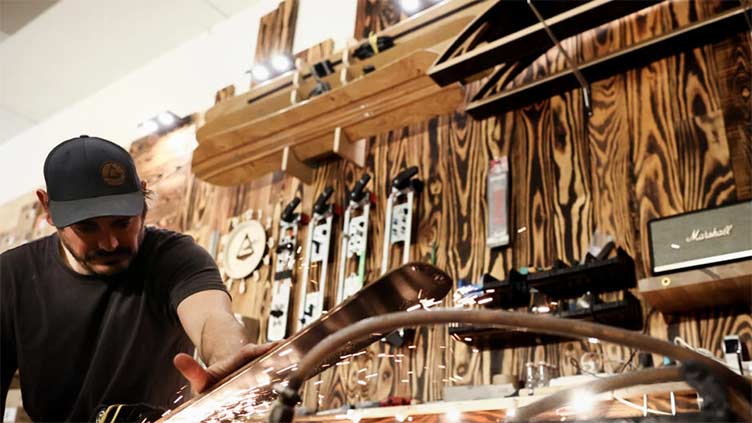In a low country, ski making is a high art

World
Gerondal's workshop in Malmedy lies in Belgium's eastern fenland.
Malmedy (Belgium) (AFP) – In a land with no mountains and scarcely ever any snow, ski craftsmanship might not seem a priority.
But Pierre Gerondal has put the limits of Belgium's geography and climate aside and carved out a respected place in the industry.
His durable made-to-measure wooden skis have attained a peak of quality and are climbing towards the summit of success.
Gerondal's workshop in Malmedy lies in Belgium's eastern fenland.
What it lacks in crisp Alpine air it gains in the smell of Douglas fir, ash and poplar ... the raw material of his craft.
"Most skis have a wooden core, but the big brands cover them in plastic. With us, everything that can be wood, stays wood," he told AFP.
Few European ski-makers still take this approach, and Gerondal's speciality helps him stand out, especially in a flat country not known for downhill racing.
"The goal is to find the eight tree species we use as close to us as possible, so that we can go and inspect the timber when it's still growing in the ground," he said.
"We choose the trees to have the most perfect wood for the construction of our skis."
The craftsman, aged in his forties, finds promising trees in the Belgian Ardennes, and also across the nearby border in the forests of France's Lorraine and of Germany's Eifel national park.
"For skis you need the heart of the tree, otherwise the blades do not offer enough resistance," he explained.
Gerondal's ski journey began barely four years ago. Before that he had worked in advertising and then in yacht design.
He used this expertise in luxury woodwork when he turned towards his real passion, skiing -- on water and, especially, on snow.
Hi-tech but artisanal
A craftsman with an environmentalist bent, and a skier since childhood, Gerondal decided to build himself a set of classic wooden skis.
His friends were impressed with the outcome and he decided to turn it into a business.
Things went downhill for two years as the Covid pandemic shut Europe's ski resorts, but the reopening coincided with a jump in interest.
He has made a hundred pairs of skis over the last 12 months and plans to make 300 more over the next year -- each pair needing 30 hours of painstaking work.
Gerondal and his two assistants regard themselves as high-tech workers but with an artisanal spirit.
"We are artists, because without the refined appearance, without the visual aspect that attracts people, we wouldn't have succeeded," he said.
"But it's also cutting-edge technology because if the finished product didn't perform at least as well as the mass-produced skis in the stores, I wouldn't have made them."
The response has been positive.
Gerondal is also helped by his partner Justine Corman, a trained graphic designer; Belgium's best Alpine skier Armand Marchant and former world champion slopestyle snowboarder Seppe Smits.
One of their products is a "splitboard", a snowboard that can be divided into two cross-country skis when a boarder goes off-piste.
'Each wood skis different'
Whether for pros like Marchant or Smits, or ski tourists getting away from the Low Countries to find themselves some altitude, each set is unique.
"Of course, before we make a pair of skis we measure and weigh the client, and try to learn about his style, his preferences," Gerondal said.
"And knowing timber is a crucial aspect in making skis, because different types of wood ski differently," he explained.
"Some skiers have weak or sensitive knees; some prefer to explore the mountains, others to carve a precise racing line down the fastest downhill slopes."
For a top end artisan, ski-making can be a lucrative business. An off-the-shelf pair can cost 2,300 euros ($2,460) and a made-to-measure set 3,800.
"Skis are like suits, they need to be adjusted. We give clients a creation to test out, They try it then come back with feedback that will allow us to make the ski that suits them best," the craftsman said.
And if that seems like a lot of trouble to go to, in a country without slopes and where ski enthusiasts need to travel to find snow, the wooden ski is built to last.
If stored and treated well, they can last for ten winter seasons.
"And there's no waste," he promised. "I ask each client never to throw out their skis. They either finish their life on the wall as decor, or they come back to Gerondal to be recycled."


